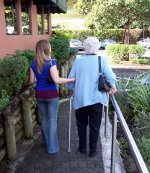Staircase Safety for Seniors
Published by Stephen on November 9, 2009 Under fall prevention Staircase safety is one of the most important aspects involved with keeping the elderly safe and free from injury, but it is also often overlooked. This is very dangerous, as falls on the stairs represent one of the leading causes of accidental injury and death among the elderly.
Staircase safety is one of the most important aspects involved with keeping the elderly safe and free from injury, but it is also often overlooked. This is very dangerous, as falls on the stairs represent one of the leading causes of accidental injury and death among the elderly.
Analyzing and Improving the Condition of the Staircase
Increasing the accessibility and safety of a staircase is not very difficult, but there are a number of aspects that must be considered. First, it is important to take into account the physical condition of the staircase. It is very important that the staircase is in good repair, with no loose boards and at least one sturdy handrail.
Studies have shown that having two handrails can significantly reduce the risk of a fall, so in homes with only one staircase railing, adding another should be considered. It is important that the handrail is not only secured well to the wall, but also that it can be easily grasped by the senior. This means that it should be small enough around for the senior to easily grasp and that it should be made of a wood that is free from splinters and rough areas. Also, the handrail should be positioned at a height that makes it easy to grasp, without having to reach up or bend down.
When considering the physical condition of the staircase, lighting is another important component to a fully accessible stairway. Not only is it important for the staircase itself to be well lit, but the top and bottom landing should also have adequate lighting. It is also important that a light switch is installed at both ends of the staircase. This is important, because otherwise, the senior might have to walk up or down the stairs in the dark if the lights were turned off.
Loose rugs and carpet runners can also pose tripping hazards. In the case of loose rugs, such as throw rugs, it is easy for a corner to become turned up or for the entire carpet to move, which can be very dangerous. In reality, these types of rugs should be removed from all areas of the home, but this is especially true around the staircase. Sometimes, staircase runners can help provide extra traction, but this is not always the case, especially if the carpet is very long, such as a shag.
Analyzing the Senior’s Abilities
While the condition of the staircase should be the first consideration and something that is regularly inspected for problems, the abilities of the senior is also an important part of creating a safe and accessible staircase. Limited vision and diseases like arthritis can make even using the most secure staircase difficult, so it is important to make an honest assessment of the seniors ability to safely use the staircase.
It is a good idea to speak with a doctor when determining the elderly individual’s abilities, as they will likely have some valuable insight into health factors that could cause a fall risk.
In cases where the senior is unable to use the stairs safely and without assistance, there are a few options. For those with limited vision, adding a textured colored tape to the steps can help make them stand out and easier to see. Consider alternating colors, with a single color used for the top and bottom step. By using a different color on the first and last step, it will make it stand out, so the senior will know when they have reached the end of the staircase. Stair lifts are another option, which are designed to carry the senior safely up the staircase.
No Comments |
Add a Comment